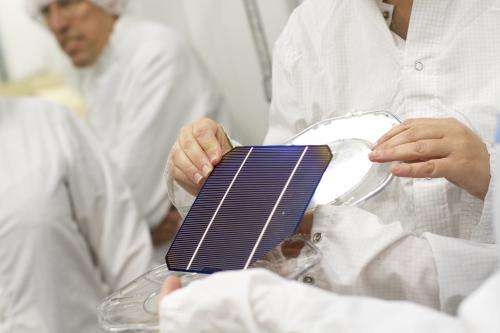Exploring environmental impacts of solar technologies

Even technologies promoted for good environmental reasons can sometimes have unforeseen negative consequences.
Such was the case in 1979 when the United States began adding methyl tertiary-butyl ether (MTBE) to gasoline to improve combustion and reduce harmful emissions. Water soluble, MTBE ended up seeping into groundwater and contaminating drinking supplies when gas leaked or spilled.
"You can't just look at performance during use," says Arizona State University research fellow Ben Wender. "We have to think about environmental impacts to air, water and soil systems across the life cycle of a product or technology."
In looking at these impacts, environmental engineers use a tool called the Life Cycle Assessment (LCA) to weigh the positive and negative environmental attributes of a new technology. The assessment analyzes the impact of a product or process at all stages – from research and development, to manufacturing and use and, finally, to future degradation and disposal.
However, the LCA tool presents a fundamental dilemma – one that engineers have grappled with for years. The tool relies on hard data that can only be collected after the product and processes have been developed and marketed – a period of time when significant, irreversible harm to the environment may already have occurred.
To address this problem, experts from ASU offer a new anticipatory approach to Life Cycle Assessment – one that explores best- and worst-case scenarios for impacts in diverse categories.
To figure out ways to anticipate multiple and varied futures with emerging technologies, researchers from two ASU centers – the Center for Nanotechnology in Society and the Quantum Energy and Sustainable Solar Technologies Engineering Research Center – teamed up to conduct research on photovoltaic cells, a rapidly emerging technology used in solar panels to convert sunlight into electrical energy.
This interdisciplinary collaboration has landed Wender and colleagues top billing in the Sept. 16 issue of the peer-reviewed journal Environmental Science and Technology.
"Most of the effort in the field of LCA is focused on achieving more precision in data," says Wender. "Often with technologies in the early development phase, there are widely varying, sometimes entirely opposing, conclusions and data."
An anticipatory approach to Life Cycle Assessment embraces rather than tries to eliminate uncertainty or conflicting data. Instead of looking at one parameter at a time, such as whether a certain substance is likely to contaminate water and to what extent, it compares many uncertain parameters to identify an environmentally promising research agenda.
Matthew Fraser, professor in the ASU School of Sustainable Engineering and the Built Environment and executive director of Quantum Energy and Sustainable Solar Technologies, agrees there is greater value when broad, but imprecise data, is included in the analysis of environmental endpoints.
"It's never A is better than B. It's usually that there are tradeoffs between A and B," says Fraser, who is also a co-author of the Environmental Science and Technology article. "There's a whole field on risk assessment to understand the weighting of different priorities for different types of contaminants in the environment, and that type of uncertainty with risk assessment isn't usually included in LCA."
Photovoltaic (PV) devices hold immense promise for producing electricity with reduced greenhouse gases but also have the potential to inadvertently introduce new environmental harm, such as when solar panels begin to wear out.
"In 15 or 20 years, we'll have to have a strategy for how to recover materials and deal with the waste generated from the decommissioning of the panels that are being installed today," says Fraser.
Anticipatory Life Cycle Assessment can also illuminate new research opportunities and help prioritize research directions and funding with the greatest environmental promise, which can reduce research costs over time.
"Improving PV cell efficiency would improve the amount of energy produced during the use phase, but it might make more sense to focus on decreasing the energy intensity during manufacturing," says Fraser. "LCA helps determine where you get the biggest bang for your buck."
Additionally, this proactive approach opens up dialogue with those outside the lab by feeding information back to "policymakers, technology developers and others who are in a position to realign the technological trajectory," says Thomas Seager, associate professor and Lincoln Fellow of Ethics and Sustainability in the ASU School of Sustainable Engineering and the Built Environment and another co-author of the Environmental Science and Technology article.
By incorporating diverse stakeholder perspectives into Life Cycle Assessment analyses, including integration with social systems, Seager adds, "we can keep science forward looking and in concert with policy and social needs."
Both the Center for Nanotechnology in Society and Quantum Energy and Sustainable Solar Technologies, which encourage interdisciplinary projects and approaches, receive funding from the National Science Foundation, and Wender's work has served as a point of collaboration between these two large-scale centers. In addition to Wender, 14 authors representing industry, government, engineering, risk assessment, and social science collaborated to develop and test the new Life Cycle Assessment approach for the journal article.
Working to broaden anticipatory Life Cycle Assessment of photovoltaic technology to include manufacturer and user input, Wender says his current studies "ultimately make LCA a much more robust approach to technology assessment," as different perspectives and disciplines are included.
Journal information: Environmental Science and Technology
Provided by Arizona State University


















